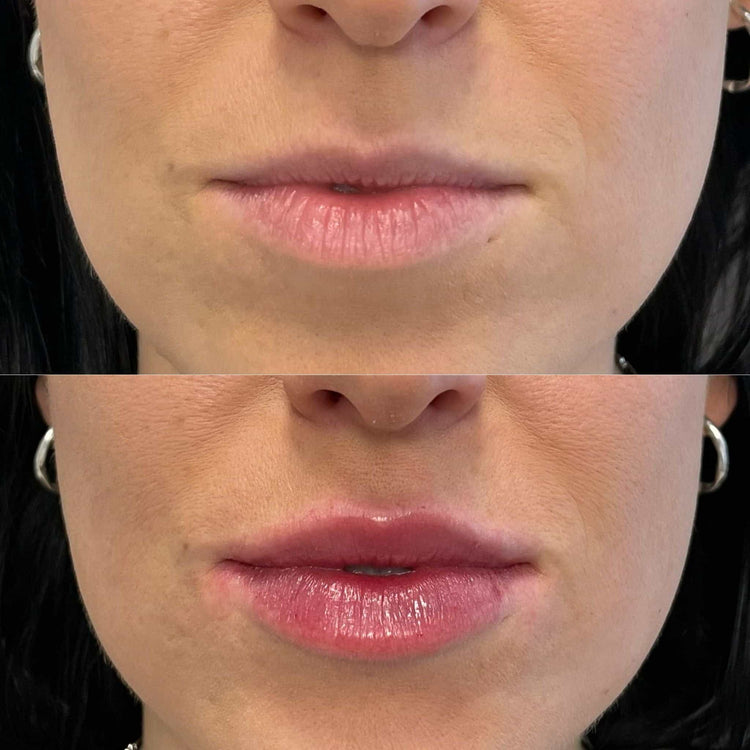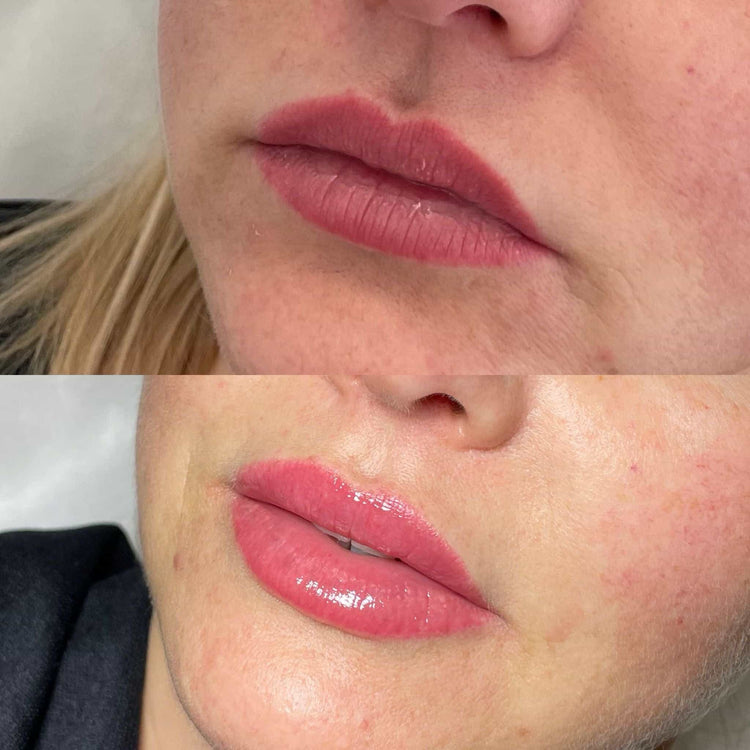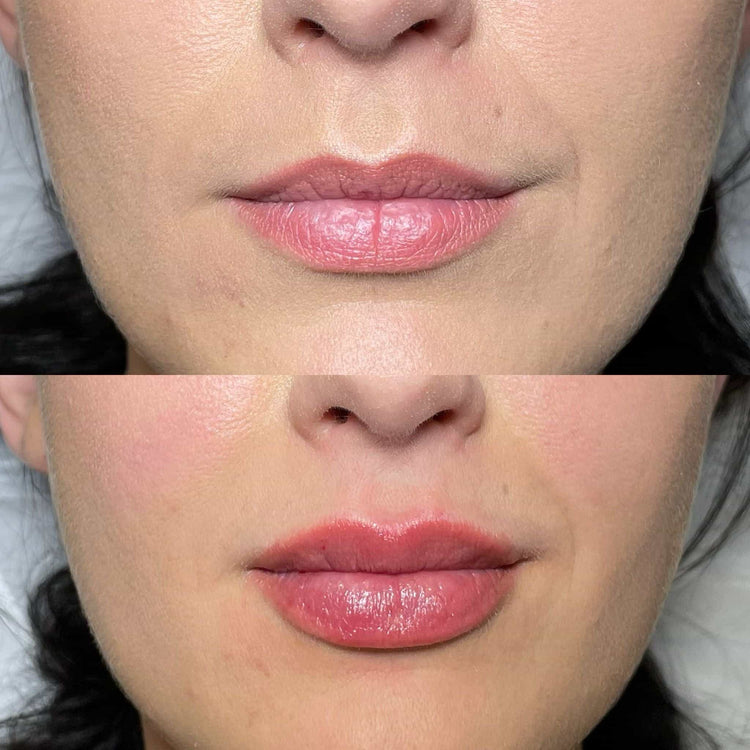The Science Behind Hyaluronic Acid Lip Fillers
What is Hyaluronic Acid?
Hyaluronic acid (HA) is a naturally occurring substance found in various tissues throughout the body, playing a crucial role in maintaining skin hydration and elasticity.
Structure and Properties
Hyaluronic acid (HA) is a naturally occurring substance found in various tissues throughout the body, playing a crucial role in maintaining skin hydration and elasticity.
This glycosaminoglycan, composed of repeating disaccharide units of glucuronic acid and N-acetylglucosamine, has a unique structure that allows it to bind water molecules.
- HA’s molecular weight varies widely, influencing its properties and applications.
- High molecular weight HA is found in the extracellular matrix, providing structural support and lubrication to tissues.
- Low molecular weight HA is more readily absorbed into the skin, offering benefits like improved hydration and reduced wrinkles.
Naturally Occurring HA in the Body
Naturally occurring hyaluronic acid (HA) is a key component of healthy skin. It’s present in various tissues throughout the body, acting as a natural humectant, attracting and retaining water molecules.

This ability to bind water contributes significantly to maintaining skin hydration, plumpness, and elasticity.
How Hyaluronic Acid Works as a Filler
Hyaluronic acid’s remarkable ability to attract and retain water makes it ideal for use as a filler. Injected beneath the skin, hyaluronic acid molecules draw in moisture, effectively plumping up the treated area. This can smooth out wrinkles, enhance lip volume, and redefine facial contours.
Attracting and Holding Water
Hyaluronic acid (HA) works as a filler by attracting and holding water molecules. Its unique molecular structure allows it to bind to these water molecules, increasing its own size and creating a plumping effect.
When injected beneath the skin, HA draws in surrounding moisture, effectively filling in wrinkles, adding volume to lips, or redefining facial contours. This volumizing effect provides a natural-looking enhancement without the need for permanent implants.
Volume Enhancement
Hyaluronic acid (HA) is a naturally occurring substance found throughout the body, playing a crucial role in maintaining skin hydration and elasticity due to its unique ability to bind water molecules.
When injected beneath the skin as a filler, HA attracts and holds onto surrounding moisture, increasing its own size and creating a plumping effect.
This volumizing action effectively smooths out wrinkles, enhances lip volume, and can redefine facial contours by adding fullness to areas where volume has been lost.
The Procedure of Hyaluronic Acid Lip Fillers
The Procedure of Hyaluronic Acid Lip Fillers
Hyaluronic acid (HA) is a naturally occurring substance found throughout the body, playing a crucial role in maintaining skin hydration and elasticity. This glycosaminoglycan, composed of repeating disaccharide units of glucuronic acid and N-acetylglucosamine, has a unique structure that allows it to bind water molecules.
When injected beneath the skin as a filler, HA attracts and holds onto surrounding moisture, increasing its own size and creating a plumping effect. This volumizing action effectively smooths out wrinkles, enhances lip volume, and can redefine facial contours by adding fullness to areas where volume has been lost.
Consultation and Planning
The procedure of hyaluronic acid (HA) lip fillers typically involves several steps. First, a consultation with a qualified injector is essential to discuss desired outcomes, medical history, and potential risks.
During the procedure, a topical anesthetic is applied to numb the area around the lips. Then, the HA filler is injected into specific points of the lip using a fine needle or cannula.
The injector carefully molds the filler to achieve the desired shape and fullness. The entire procedure usually takes less than 30 minutes.
Immediately after the treatment, there may be some temporary swelling, redness, or bruising around the injection sites.
These side effects typically subside within a few days. Patients are advised to avoid touching or rubbing the treated area and to keep it clean.
Injection Process
The procedure of hyaluronic acid (HA) lip fillers typically involves several steps. First, a consultation with a qualified injector is essential to discuss desired outcomes, medical history, and potential risks.
During the procedure, a topical anesthetic is applied to numb the area around the lips. Then, the HA filler is injected into specific points of the lip using a fine needle or cannula.
The injector carefully molds the filler to achieve the desired shape and fullness. The entire procedure usually takes less than 30 minutes.
Immediately after the treatment, there may be some temporary swelling, redness, or bruising around the injection sites. These side effects typically subside within a few days. Patients are advised to avoid touching or rubbing the treated area and to keep it clean.
Post-Procedure Care
Post-Procedure Care for Hyaluronic Acid Lip Fillers
Following hyaluronic acid (HA) lip filler treatment, proper aftercare is essential to minimize side effects and optimize results. It is important to follow your injector’s specific instructions carefully.
Here are some general guidelines for post-procedure care:
- Avoid touching or rubbing the treated area
- Apply ice packs to reduce swelling
- Keep the lips hydrated with lip balm
- Avoid strenuous activity or exercise for a few days
- Refrain from consuming alcohol or smoking
- Do not use any products containing retinol or acids
- Attend follow-up appointments as directed by your injector
It’s crucial to be aware that swelling and bruising are normal side effects and will typically subside within a few days. If you experience any unusual symptoms, such as excessive pain, infection, or allergic reaction, seek medical attention immediately.
By following these post-procedure care instructions, you can help ensure optimal healing, minimize discomfort, and achieve the desired results from your hyaluronic acid lip fillers.
Benefits of Hyaluronic Acid Lip Fillers
Hyaluronic acid (HA) is a natural substance found in various tissues throughout the body, playing a crucial role in maintaining skin hydration and elasticity. This glycosaminoglycan’s unique structure allows it to bind water molecules, attracting and retaining moisture. When injected beneath the skin as a filler, HA attracts surrounding moisture, effectively plumping up the treated area.
Increased Lip Volume and Shape
Hyaluronic acid lip fillers offer numerous benefits, primarily focusing on increasing lip volume and achieving desired shape. The natural ability of hyaluronic acid to attract and retain water allows it to plump up the lips, creating a fuller appearance.
This non-surgical approach provides a noticeable enhancement to lip size and definition without resorting to permanent implants.
Hydration and Plumpness
Hyaluronic acid (HA) is a naturally occurring substance that plays a crucial role in maintaining skin hydration and plumpness.
When injected as a filler, HA attracts water molecules, effectively increasing its own size and creating a volumizing effect. This makes it ideal for enhancing lip volume and achieving a fuller, more defined appearance.
The increased moisture content also contributes to smoother skin texture, reducing the appearance of wrinkles and fine lines around the lips.
Non-Surgical and Reversible
Hyaluronic acid (HA) is a naturally occurring substance that plays a crucial role in maintaining skin hydration and plumpness. When injected as a filler, HA attracts water molecules, effectively increasing its own size and creating a volumizing effect. This makes it ideal for enhancing lip volume and achieving a fuller, more defined appearance.
- Enhanced Lip Volume: Hyaluronic acid fillers add volume to the lips, making them appear fuller and more plump.
- Natural-Looking Results: The gradual and subtle volumizing effect of HA fillers provides a natural-looking enhancement rather than an overly artificial appearance.
- Reversible Treatment: Hyaluronic acid is a temporary filler. When desired, the results can be reversed by using an enzyme called hyaluronidase, which breaks down the HA.
- Minimal Downtime: The procedure is relatively quick and involves minimal downtime. Most patients can return to their usual activities immediately after treatment.
- **Safety and Effectiveness:** Hyaluronic acid is a well-tolerated and safe substance when used for cosmetic purposes. Numerous studies have demonstrated its effectiveness in lip augmentation.
Risks and Side Effects
Like any medical procedure, hyaluronic acid lip fillers carry potential risks and side effects. While generally considered safe, it’s important to understand these potential complications before undergoing treatment. Common side effects include temporary swelling, redness, bruising, tenderness, and itching around the injection sites.
Temporary Swelling and Bruising
Temporary swelling and bruising are common side effects of hyaluronic acid lip fillers and usually subside within a few days.
It’s essential to follow your injector’s instructions for post-treatment care, which may include applying ice packs, avoiding touching the treated area, and using lip balm to keep the lips hydrated.
If you experience any unusual symptoms or severe side effects, such as excessive pain, infection, or allergic reaction, seek medical attention promptly.
Infection Risk
Although hyaluronic acid fillers are generally safe, it is important to be aware of potential risks and side effects.
Temporary side effects like swelling, redness, bruising, tenderness, and itching around the injection sites are common and usually subside within a few days.
More serious, but less common, risks include infection, allergic reactions, and vascular complications (where the filler accidentally blocks blood flow). It is crucial to consult with a qualified and experienced injector who will assess your individual risk factors and provide appropriate guidance.
Before undergoing any procedure, discuss potential risks and side effects thoroughly with your injector to make an informed decision.
Allergic Reactions
Like any medical procedure, hyaluronic acid lip fillers carry potential risks and side effects. While generally considered safe, it’s important to understand these potential complications before undergoing treatment. Common side effects include temporary swelling, redness, bruising, tenderness, and itching around the injection sites.
These side effects are usually mild and subside within a few days. It is important to follow your injector’s instructions for post-treatment care, which may include applying ice packs, avoiding touching the treated area, and using lip balm to keep the lips hydrated.
More serious, but less common, risks include infection, allergic reactions, and vascular complications (where the filler accidentally blocks blood flow). If you experience any unusual symptoms or severe side effects, such as excessive pain, infection, or allergic reaction, seek medical attention promptly.

It is crucial to consult with a qualified and experienced injector who will assess your individual risk factors and provide appropriate guidance. Before undergoing any procedure, discuss potential risks and side effects thoroughly with your injector to make an informed decision.
Long-Term Considerations
While hyaluronic acid lip fillers offer numerous advantages, it’s essential to consider the long-term implications of this cosmetic procedure.
Longevity of Results
The longevity of results from hyaluronic acid lip fillers varies depending on individual factors such as metabolism, lifestyle, and the specific type of HA filler used. On average, hyaluronic acid fillers typically last between 6 to 18 months.
Over time, the body gradually breaks down the hyaluronic acid molecules, leading to a gradual reduction in volume and plumpness.

To maintain the desired results, repeat injections are necessary.
The frequency of touch-up appointments will depend on your individual needs and how quickly you experience fading of the filler.
Touch-Up Treatments
The longevity of hyaluronic acid lip fillers varies depending on individual factors such as metabolism, lifestyle, and the specific type of HA filler used. On average, hyaluronic acid fillers typically last between 6 to 18 months. Over time, the body gradually breaks down the hyaluronic acid molecules, leading to a gradual reduction in volume and plumpness.
To maintain the desired results, repeat injections are necessary. The frequency of touch-up appointments will depend on your individual needs and how quickly you experience fading of the filler.
Alternative Fillers
Long-term considerations for hyaluronic acid lip fillers involve understanding that the results are temporary.
Hyaluronic acid is naturally broken down by the body over time, meaning touch-up injections will be needed to maintain the desired volume and fullness.
The longevity of these fillers can vary from person to person, typically ranging from six months to eighteen months.
Factors influencing duration include metabolism, lifestyle, and the specific type of hyaluronic acid used.
Open communication with your injector about your desired outcome and long-term goals is essential for developing a personalized treatment plan that addresses your individual needs and expectations.
Alternative fillers like poly-L-lactic acid (PLLA) or calcium hydroxylapatite (CaHA) offer longer-lasting results, though they may have different properties and side effects compared to hyaluronic acid.
Book your consultation for lip fillers with Dr. Laura Geige at It’s Me & You Clinic
- Gummy Smile Treatment – Gum Contouring Near Mickleham, Surrey - September 23, 2025
- Filler For Volume Loss In Knaphill, Surrey - September 22, 2025
- Downturned Smile Treatment Near Shackleford, Surrey - September 19, 2025
